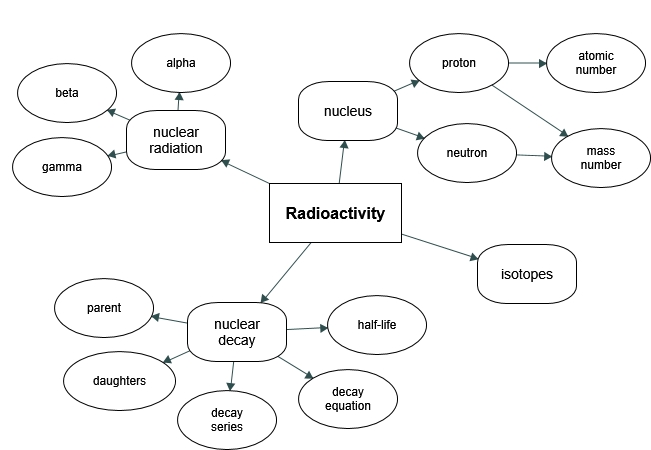54 Main Ideas
Concept Map

Key Terms
- activity
- the rate of decay for radioactive nuclides
- alpha decay
- type of radioactive decay in which an atomic nucleus emits an alpha particle
- alpha rays
- one of the types of rays emitted from the nucleus of an atom
- antielectron
- another term for positron
- antimatter
- composed of antiparticles
- atomic mass
- the total mass of the protons, neutrons, and electrons in a single atom
- atomic number
- number of protons in a nucleus
- beta decay
- type of radioactive decay in which an atomic nucleus emits a beta particle
- beta rays
- one of the types of rays emitted from the nucleus of an atom
- binding energy
- the energy needed to separate nucleus into individual protons and neutrons
- daughter
- the nucleus obtained when parent nucleus decays and produces another nucleus following the rules and the conservation laws
- decay
- the process by which an atomic nucleus of an unstable atom loses mass and energy by emitting ionizing particles
- decay constant
- quantity that is inversely proportional to the half-life and that is used in equation for number of nuclei as a function of time
- decay equation
- the equation to find out how much of a radioactive material is left after a given period of time
- decay series
- process whereby subsequent nuclides decay until a stable nuclide is produced
- gamma decay
- type of radioactive decay in which an atomic nucleus emits a gamma particle
- gamma rays
- one of the types of rays emitted from the nucleus of an atom
- mass number
- number of nucleons in a nucleus
- neutrino
- an electrically neutral, weakly interacting elementary subatomic particle
- neutron
- a neutral particle that is found in a nucleus
- nuclear radiation
- rays that originate in the nuclei of atoms, the first examples of which were discovered by Becquerel
- nuclear reaction energy
- the energy created in a nuclear reaction
- nucleons
- the particles found inside nuclei
- nucleus
- a region consisting of protons and neutrons at the center of an atom
- parent
- the original state of nucleus before decay
- photomultiplier
- a device that converts light into electrical signals
- positron
- the particle that results from positive beta decay; also known as an antielectron
- positron decay
- type of beta decay in which a proton is converted to a neutron, releasing a positron and a neutrino
- protons
- the positively charged nucleons found in a nucleus
- radioactive
- a substance or object that emits nuclear radiation
- radioactive dating
- an application of radioactive decay in which the age of a material is determined by the amount of radioactivity of a particular type that occurs
- radioactivity
- the emission of rays from the nuclei of atoms
More terms can be found in the chapter 31 in the textbook.

